The role of President of what is now Irish Sailing is central to our activities afloat. The diverse boating community that the President both serves and represents is affected by the variable socio–economic circumstances in which our sport - in its broadest sense – is functioning and developing. The way that the organisation lead by the President evolves to suit changing sailing and boating needs, the way that it caters for the requirements of ordinary sailors, and the level of international success achieved by our leading athletes - these factors affect us all.
Interwoven through every aspect of Irish Sailing and the diverse activities it caters for, the personality and abilities of the holder of the position of President play a key background role in our sailing and boating. They can significantly affect how we the participants see and experience what we do, and how the rest of the world perceives us. W M Nixon takes a look back to the roller-coaster of experience provided for Irish sailing in recent years, and tells us more about Jack Roy, the new President.
In the fallout years during and after the economic recession which began in 2008, what was then the Irish Sailing Association found itself in a complex and often conflicting situation. Shrinking consumer demand among ordinary sailors resulted in severe financial constraints, with painful cutbacks within the organisation and in the services it could provide to the wider sailing community. As for the customer base, most of them did their sailing through clubs which were themselves going through varying levels of trauma both in terms of declining active membership, and years of financial challenge.
Yet at the same time Ireland’s international sailors within the Olympic framework, and at other levels such as the Commodore’s Cup win captained by Anthony O’Leary in 2014, were showing great achievement and promise. This was to result in internationally-recognised success in 2016 when Annalise Murphy won the Silver Medal in the Laser Radial at the Rio Olympics. It was an achievement that significantly raised the mood nationally in an Ireland still struggling with the continuing effects of recession. And within sailing, it provided a boost of extra confidence in a sport which, despite an undoubted though arguably temporary shrinkage in numbers actively involved, had continued at its core level through the resilience of its truest adherents.
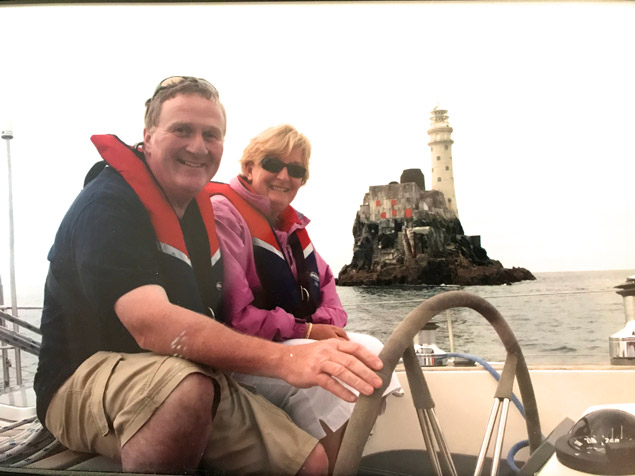 The relaxed helmsman. Jack Roy and his wife Rosemary on their Hallberg Rassy 46 Tangaroa at the Fastnet Rock during a West Cork cruise
The relaxed helmsman. Jack Roy and his wife Rosemary on their Hallberg Rassy 46 Tangaroa at the Fastnet Rock during a West Cork cruise
Inevitably the economic pressures had required some drastic cutbacks, and significant changes of direction in management. The Board of the Irish Sailing Association (ISA) decided that only by bringing in new blood could they ensure the necessary change of course, and in 2014 David Lovegrove became President for a three year period, despite not having been a Board member beforehand.
He brought a clear-eyed outsider’s view with exceptional experience both as a dinghy and keelboat sailor, as a former Commodore of Howth Yacht Club during its Centenary Year of 1995, and as an internationally-recognised Race Officer.
The very conscientious Lovegrove, a notably private person, was reckoned to be the safe pair of hands needed to guide the Association out of the wilderness. Much of this was done through quiet work behind the scenes, while the more public side of the ISA was represented by the High Performance division. In better economic times, the clubs and other boating organisations may be entitled to capital grants from governmental sports bodies. But in a period of financial stringency, the serious public money coming into sailing is basically aimed at Olympic success, for the truth is that Olympic sailing is the only branch of the sport to register at the required level of public interest.
Thus it was a difficult course the new President had to tread between introducing economy of expenditure – sometimes extreme economy – at most levels, while at the same time helping potential Olympic athletes make the best of what was available. For although it was in amounts much greater than any funding going to other areas of Irish sailing, it was almost absurdly small by comparison with major sailing nations.
It all came good in August 2016 with that marvellous medal win in Rio, while back home the green shoots of early recovery had long since developed into vigorous and broadly-based growth, even if some of those seriously damaged by the recession will never fully recover. But Irish sailing had come through, and in March this year David Lovegrove stood down as ISA President, and stood down as well from the Board to return to his core interests of club sailing and acting as a highly-regarded Race Officer at home and abroad.
Jack Roy, his successor as President until 2020, continues to bring to the job many of the qualifications and abilities David Lovegrove provided, yet the new President is a very different personality. Affable and outgoing, his exuberant and infectious enthusiasm informs everything he does, so much so that if he had a philosophy of life, it might be something on the lines if: “If you aren’t enjoying it, then why are you doing it?”
Admittedly if you went into David Lovegrove’s various interests, you’d find that in his very quiet way, he has much the same attitude. But while he was the ideal person to be President in the harsh recessionary times, Jack Roy is the ideal man at the helm when the going gets good.
It’s not that he hasn’t steered some organisations successfully through some very thin times, for he most definitely has. But somehow as the pace begins to pick up again, it seems right and proper that Jack Roy is holding the course.
So who is he, our new steersman? Well, he’s also a relative newcomer to the inner circles of the national sailing authority, as he was only brought onto the Board as recently as 2013, when the scale of the problems the ISA faced were becoming abundantly clearer by the day. The powers-that-be reckoned that as an active sailor, a fully accredited International Race Officer since 1998, an International Technical Officer (ITO) at the 2012 Olympics, and the instigator of many organisations and innovations in sailing, Jack Roy had the qualities they badly needed in Irish sailing’s national hours of need.
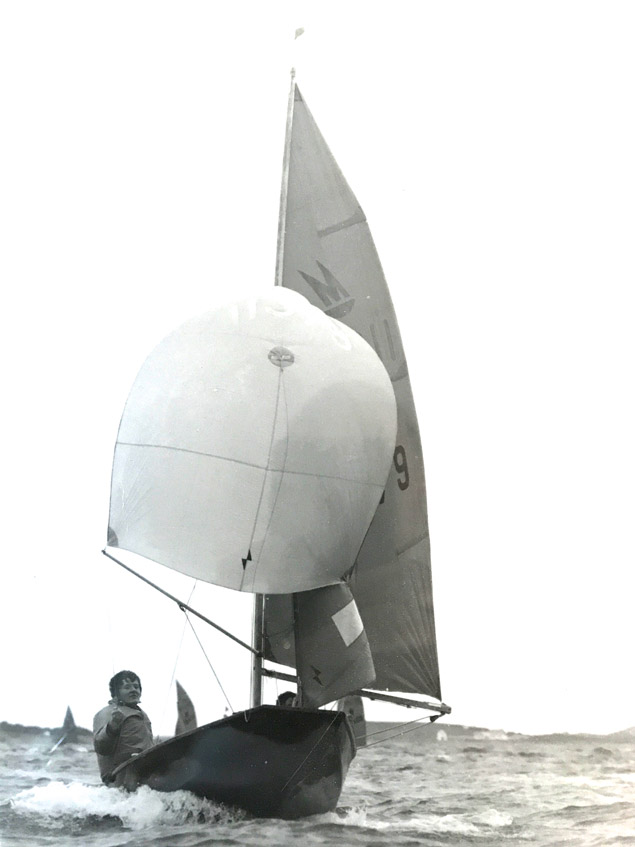 The first boat - the Mirror dinghy he built with his father in 1967 – means that this year, Jack Roy celebrates 50 years in sailing. The photo was taken at the Mirror Worlds in Sligo in 1973. Photo: John Fitzpatrick/courtesy Roy family
The first boat - the Mirror dinghy he built with his father in 1967 – means that this year, Jack Roy celebrates 50 years in sailing. The photo was taken at the Mirror Worlds in Sligo in 1973. Photo: John Fitzpatrick/courtesy Roy family
Having served four years on the Board, he has been President for nearly four months now. And a very busy four months they’ve been too, both for Irish sailing and the President, as he implements a policy of being personally present at as many major events as possible, while continuing his voluntary duties as a race officer with Dublin Bay SC every Thursday evening, and taking in the same task at several top events including the ICRA Nationals in Cork in June, and the recent Dun Laoghaire Regatta in Dublin Bay.
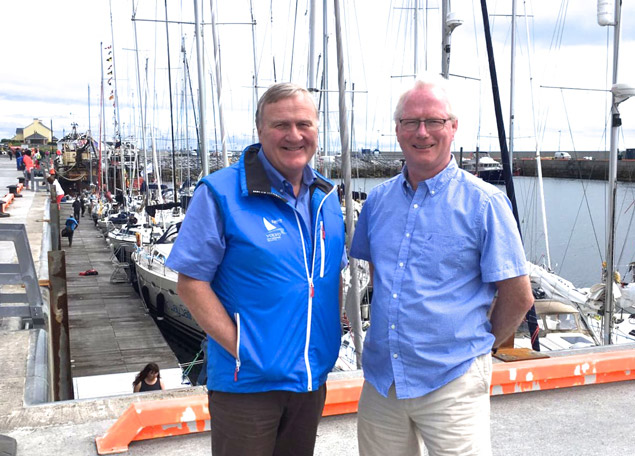 Jack Roy with event organizer Cormac Mac Donnacha at the first day of the WIORA Championship on the Aran Islands on Wednesday July 5th. That same evening, he was present at the Civic Reception in Dun Laoghaire Town Hall for the official opening of the four day Volvo Dun Laoghaire Regatta 2017. Racing in that started racing next day, and he served as one of the Race Officers throughout
Jack Roy with event organizer Cormac Mac Donnacha at the first day of the WIORA Championship on the Aran Islands on Wednesday July 5th. That same evening, he was present at the Civic Reception in Dun Laoghaire Town Hall for the official opening of the four day Volvo Dun Laoghaire Regatta 2017. Racing in that started racing next day, and he served as one of the Race Officers throughout
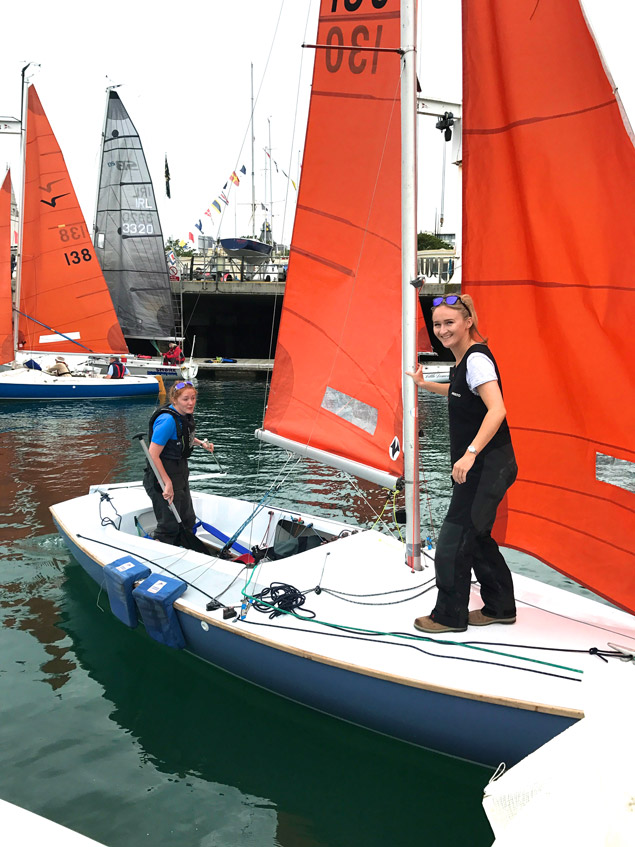 Jack Roy’s daughters Jill and Suzie taking the family Squib out to race in the Volvo Dun Laoghaire Regatta while their father was busy running one of the race areas
Jack Roy’s daughters Jill and Suzie taking the family Squib out to race in the Volvo Dun Laoghaire Regatta while their father was busy running one of the race areas
That mega-event marked a watershed in the 2017 season as the annual programme begins to shift its emphasis towards the late July and August schedules, so this week we managed to find a breathing space to get together in the cool peace of one of the Dun Laoghaire clubs in its pleasantly informal post-regatta mode, and Afloat.ie was given the opportunity to learn a bit more about Jack Roy.
Of course, just about every active sailor knows Jack Roy, in that he officiates at major events afloat, speaks passionately yet with wit and humour at many diverse functions ashore, and is himself a keen sailor aboard one of his two boats whenever he gets the opportunity. He exudes enthusiasm and energy so much you might call him a force of nature, and the story of his lifepath is one with which the entire Irish sailing community can readily identify, for all that he is a classic south County Dubliner through and through.
He’s a south Dub despite the fact that he was born in Greystones in 1958. His father – from Sandymount – had reputedly run away to sea as a boy, but in time the runaway became a leading figure in Dublin in the marketing and installation of lighting of all kinds to an industrial level. Yet the call of the sea was strong, so one of his sports was sailing, and among the craft he sailed aboard was Bonito of 1874 vintage, owned by Dun Laoghaire character Roy Starkey, and crewed by one Bob Geldof and his various relations.
An upshot of all this is that Jack Roy is a cousin of Bob Geldof Jnr. The precise details of who married whom and when and where is beyond the scope of this blog, but it’s all of a piece that Jack Roy is a cousin of Bob Geldof and is a true South Dub despite spending the early years of his boyhood in a seaside town in north County Wicklow.
While his father worked in the lighting business in Dublin and also established and ran a business in the same line in Manchester, he and Jack’s mother were very much involved in Greystones life, what with her involvement for many decades on behalf of the RNLI, and their shared interest in boats and the sea. They were both to become founder members of Greystone Sailing Club in 1968, and his father John was one of the leading figures in the late-1960s development of Greystones Harbour.
That all sounds like a much grander project than it really was. What happened was that the first attempt to use pioneering techniques to build a lighthouse for the Kish Bank off Dublin Bay in the 1960s ended in failure when the reinforced concrete structure cracked as it was being towed out to the Kish Bank from its building site in the Coal Harbour in Dun Laoghaire. The entire structure – including its large circular base – was condemned, but a second successful attempt to build the Kish Lighthouse was soon under way.
Meanwhile the maritime men of Greystones saw an opportunity to improve their tiny harbour at a stroke. They reckoned that the original soon-to-be-demolished base for the Kish Lighthouse would provide a ready-made basis for an enlarged breakwater at their home port, so they struck a deal, and a long slow tow brought the floating cast concrete base to its new home. It was moored up for the night to be ready for final placing and filling the following day, and then everyone adjourned to the Beach House for celebratory pints until a late hour.
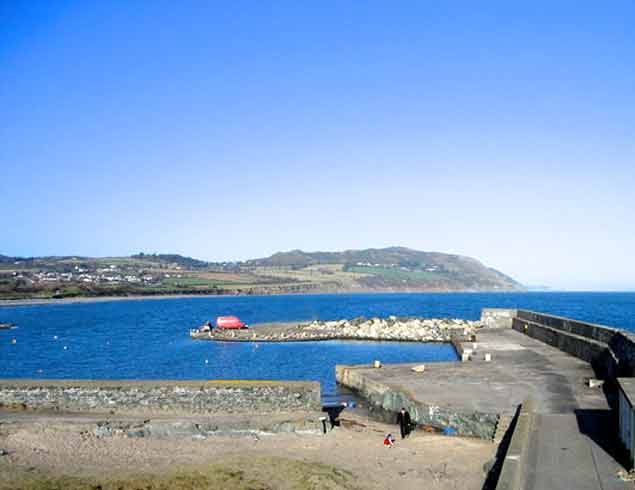 Greystones Harbour with its new breakwater as installed in the late 1960s. Jack Roy’s father John was one of those involved in acquiring the base of the experimental Kish Lighthouse for re-use as the main part of the breakwater. The former lighthouse base is under the red van in the photo
Greystones Harbour with its new breakwater as installed in the late 1960s. Jack Roy’s father John was one of those involved in acquiring the base of the experimental Kish Lighthouse for re-use as the main part of the breakwater. The former lighthouse base is under the red van in the photo
But when everyone looked out in the morning to admire yet again the basis for their new pier, there it was – gone. The ebb tide had taken it away. Fortunately, it had gone no further than South Beach, and they managed to get it back and set in place on a more permanent basis to be the basis of Greystones Harbour for many years. But with the much more recent new harbour work at Greystones, you’d need to be an archaeologist to find the old base of the first Kish Lighthouse, though it’s probably somewhere deep under the new Greystones Sailing Club building.
Back in 1967, the sailors of Greystones made the move into Mirror dinghies, and John Roy built one with his son’s help. Today, Jack Roy has only to get the whiff of fibreglass work under way to be transported on a wave of nostalgia back to the happy days when he and his dad were building his Mirror in the garage fifty years ago, which means he has become president of the Irish Sailing Association in the same year that he celebrates fifty years of being an active owner-skipper.
With an equally young Pearse Dunne as crew, Jack Roy campaigned the Mirror with growing expertise, but when Greystones Sailing Club – formed the year after the Roy family had built their Mirror – began to plan a move up into Enterprise dinghies which could also be home built, young Jack showed his distinct streak of individuality. While the Enterprise was an attractive boat, she didn’t have a spinnaker and she didn’t use a trapeze, and the 16-year-old Jack Roy wanted both, so in 1974 he threw in his lot with the developing International 420 Class in the National Yacht Club in Dun Laoghaire.
While Greystones still remains very special to him, by this time has life increasingly revolved around south Dublin, where he was a pupil at Blackrock College and then St. Gerards in Bray. He was drawn into the trophy-winning rugby team at Blackrock, displaying his talents as a loosehead prop in the thick of the scrum. It’s a character-building position, to say the least. And as Jack quips, it gives you a very thick neck, which is a very good thing to have if you’re going to give frequent service as a race officer in sailing.
It also reinforced his enthusiasm for team effort. He is at his best in a team in any role including captain, and in a sense this was reflected in his sailing, as he never became personally involved in the growing number of single-handed classes which were developing throughout Ireland.
His sailing nevertheless was proceeding apace, with a new 420 and international competition. But surely the most important thing to have happened to him is that in 1975 he met Rosemary Dobbyn. He was aged just 17. He was smitten. By the time he was 23, they were married. They continue to be so much together that they work together, and on his race officer duties, she is the timekeeper.
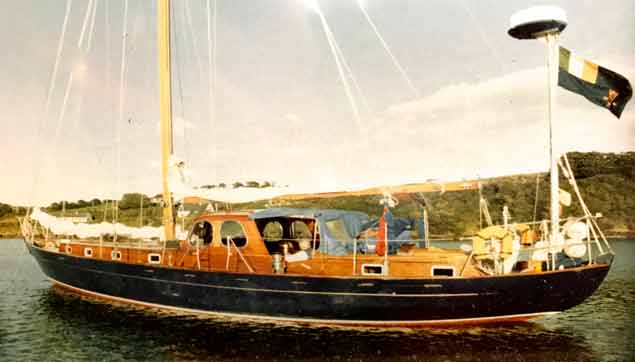 The Roy family’s William Garden-designed 52-footer Pegeen in Castletownshend, West Cork. Pegeen played a key role in family life from 1975 to 1989
The Roy family’s William Garden-designed 52-footer Pegeen in Castletownshend, West Cork. Pegeen played a key role in family life from 1975 to 1989
By this time his parents were expanding their own interests afloat, and there was much family cruising with a variety of craft, starting in 1972 with a Scottish-built 36ft Miller Fifer Motor-Sailer. But one day in Arklow they spotted a 52ft American sloop Pegeen newly in from a rough Atlantic crossing which had cured the owners’ enthusiasm for voyaging. Jack’s father was drawn to the boat and after length negotiations he finally secured her, and from 1975 to 1989, Pegeen was central to the Roy family life for all generations.
Designed by William Garden and teak-built in 1957 in China, Pegeen taught Jack much of what he knows about cruising, and she taught him almost more than he wants to know about maintaining a wooden boat. She also broadened his knowledge about Irish sailing locations – having cruised the places conveniently reached from Dublin Bay since 1975, from 1981 onwards the Roy family based Pegeen in East Ferry in Cork Harbour, commuting to her at weekends and making West Cork into their ideal of cruising perfection.
Yet at the same time young Jack’s racing career was developing in Dublin Bay and at international events, while he took the clearcut step of going straight from school into the family industrial lighting business, immediately showing a very strong work ethic. With the Irish construction industry being volatile, to say the least, the family’s Manchester business had a significant role to play, and for a while Jack and Rosemary lived and worked there.
But they decided Ireland was always to be their home, they settled in Loughlinstown southwest of Dun Laoghaire and are still in the same area, though in a different house. Jack immersed himself in the family’s Dublin business while Rosemary worked as a midwife in the National Maternity Hospital in Holles Street, rising through the front line ranks to register 22 years of service to Ireland’s population boom.
Jack and Rosemary Roy are both grafters, it’s central to what they are - it’s the way they approach things and they believe both in hard work and in enjoying it too. So somehow while developing and guiding the lighting business on Jack’s side and putting in long hours in Holles Street on Rosemary’s, they became a family with daughters Jill and Suzie, while Jack’s sailing – based now at the National Yacht Club – moved onto a new level with his devoted involvement with the Flying Fifteen class.
Not that all ties with family cruising were dropped, for although the increasingly-demanding Pegeen was sold in 1989, Jack’s parents promptly replaced her for another ten years of cruising with the Nicholson 38 ketch Conche, a much easier maintenance proposition with her fibreglass hull and more manageable size.
But since 1981 – after a brief flirtation with the International 470 – Jack Roy’s racing was with the Flying Fifteen class, and with crewman Mal Nowlan – who continues as a good friend and a member of his Race Management team – he was increasingly there or thereabouts at the front of the Flying Fifteen class.
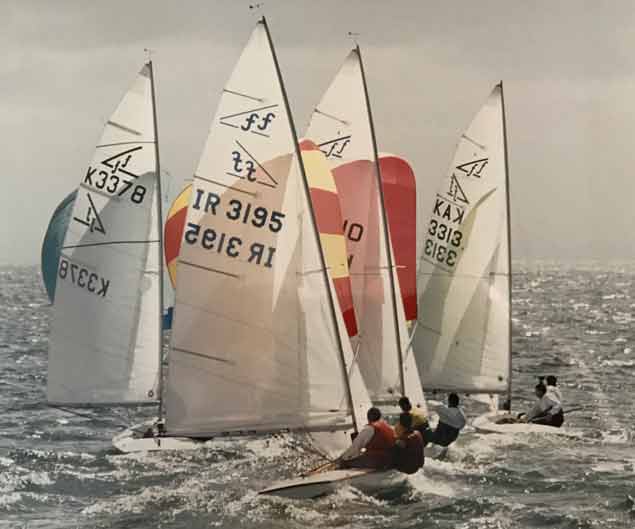 Jack Roy racing his Flying Fifteen Ffrisbee (3195) at the Worlds in Dublin Bay in 1992, crewed by newcomer Dave Gorman. They were getting places up to fourth
Jack Roy racing his Flying Fifteen Ffrisbee (3195) at the Worlds in Dublin Bay in 1992, crewed by newcomer Dave Gorman. They were getting places up to fourth
And he was being drawn into many aspects of sailing administration, by 1986 becoming Honorary Sailing Secretary of the National Yacht Club. One evening, it was discovered that the designated Race Officer was a no show, so Jack took on the job just for that evening’s racing. But he discovered he’d a taste and a talent for it, and particularly enjoyed finding it was a team effort rather than a one man band. A new strand had been added to his already busy sailing career and demanding working life.
At the same time, he was increasingly involved in the shoreside politics of sailing through the Flying Fifteens, finding that he much enjoyed the increased range of friendships which international events provided – he continues to have good friends in New Zealand as a result of the Flying Fifteen Worlds in Kinsale in 1984.
However, he was concerned with the way that the Flying Fifteen class in Ireland, now spread through the country but with its longest-established centres in the north, seemed increasingly to be reduced to being a subsidiary of the British class association, which he feared would limit the number of places available to Irish sailors at World Championships. So he patiently set about creating a new entity, the Flying Fifteen Association of Ireland, and after much quiet negotiation behind the scenes, he had the basics in place and needed one final piece of the jigsaw to make it complete.
To give it credibility in the north in what was still the depths of the Troubles, that final piece of the jigsaw which he had to find was a leading Northern Ireland Flying Fifteen sailor to take on the role of President, and in Jim Rogers of Kircubbin on Strangford Lough he found the ideal man to give backbone to an organisation which gave the class a new lease of life throughout the country.
This was to become evident at the highly successful International Fying Fifteen Worlds at the National Yacht Club in 1992, in which Jack was deeply involved both as a competitor and in the background organisation, though his regular crewman Mal Nowlan was even more deeply involved ashore, so Jack had to introduce a new crew, one Dave Gorman, who has since gone on to be Irish Flying Fifteen champion.
But by this stage even Jack Roy had to cut back on some aspects of his life as his work level in the growing family business – which he was to head up from 1995 onwards – increased with the growth in the Irish economy, and he and Rosemary were now proud parents of their two girls.
He knew he enjoyed the occasional sailing foray into other classes – he was to do two major campaigns in International J/24 racing with longtime sailing friend Roger Bannon – and his increased involvement with Race Management provided a measurable level of participation with a sport he loved, so in 1993 he sold out of the Flying Fifteen class and went boat-less for a whole four years. But being the man he is, his Race Officer duties were in the ascendant at home and abroad, and in 1998 the world sailing body – the International Sailing Federation since 1996 – officially accredited him as an International Race Officer.
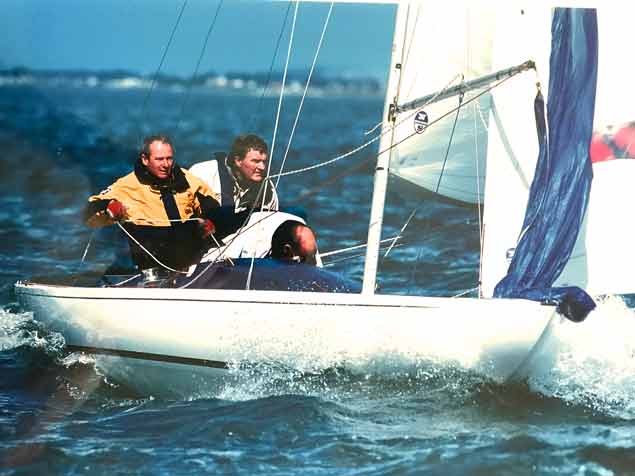 Declan Hayes, Jack Roy and Andrew Mackey in the thick of it, racing their International Dragon Sabbatical in 1998. Photo: Brendan Fogarty
Declan Hayes, Jack Roy and Andrew Mackey in the thick of it, racing their International Dragon Sabbatical in 1998. Photo: Brendan Fogarty
But by that time the call of boat ownership had again become too strong, and since 1997 he’d owned an International Dragon with Andrew Mackey. Quite how he combined his new international duties with co-ownership of a demanding boat in a hot class heaven only knows, but within a year he’d rationalized it by transferring his sailing base to the Royal Irish YC and moving into another Dragon still in partnership with Andrew Mackey, but with Declan Hayes added to the ownership team.
They kept this going for five years, which is good going in such a challenging class environment, and had a huge amount of sport at many venues. But by 2003 the work/life/sport balance had become so hectic that he again relinquished boat ownership, and gave all his sailing attention to Race Management while much of his energy ashore was taken up with the family business.
It was a time of crazy expansion in the Irish construction industry, and anyone providing the best quality industrial lighting installation and follow-up was on the crest of the wave. The family firm which Jack now headed was unbelievably busy, and Jack found himself entertaining an interest from his main Swedish suppliers to take a stake in the business.
He and Rosemary were consdering this when the offer came through from Sweden in 2007 of a complete takeover. This was something else altogether. This was the family firm, central to their sense of self. Jack found himself going back to Greystones in the evenings to pace the beach of his childhood, and ponder what they should do. It was no easy matter. But when he realised that he wouldn’t expect his two daughters to go into a business which could involve working with some of the toughest elements in the construction industry, he was finally persuaded that selling the company was the sensible thing to do, with himself and Rosemary, who had now retired from Holles Street, staying on as managers and consultants until 2010.
It was a lifestyle-changing decision, for although they had no intention of moving from their friendly neighbourhood of Loughlinstown and the house they knew so well, it finally enabled Jack to buy himself a cruising boat of which he was sure his late father would have approved. The comfortable Pegeen had been the boat which defined the Roy family’s sailing, and Jack reckoned a Hallberg-Rassy 46 would be the nearest thing to a modern equivalent, so in 2007 Tangaroa became part of the family.
For the first few years of their ownership, she was based in Dun Laoghaire to cruise nearby areas, while his involvement with competitive sailing was continued with extensive race management and other duties in that area, reaching a new peak with his period as International Technical Officer at the 2012 Sailing Olympics at Weymouth.
But while progress afloat was steadily upwards, the world of business which he’d expected to leave in 2010 was crashing into the depths of the recession. The company may now have been owned by an international Swedish-based PLC, but Jack felt that in the new extremely harsh circumstances, they’d close down the Irish operation when he walked out the door for the last time, as he was entitled to do by 2010.
However, he couldn’t contemplate the idea, and negotiated an extension of contract so that he – with Rosemary’s assistance, for she had long since retired from Holles Street – could guide the Irish company back to health, which they’ve since been able to do, though it was quite a struggle at times.
But there was already a glimmer of light by the time he went to the Olympics in 2012. Yet at times the stress must have shown, so although they still had Tangaroa – by now based in Kinsale - in the winter of 2013-14 his daughter Jill surprised him by suggesting that they should get a boat which he could race in Dublin Bay, crewed by her.
 Man at work. Jack Roy in Race Officer mode at last month’s ICRA Nats at Crosshaven, wearing his cherished National 18 cap. The Crosshaven-inspired National 18 Ultras tick all the boxes for him, as they involve team work with a crew of three, and they set a spinnaker and use trapezes. Photo: Bob Bateman
Man at work. Jack Roy in Race Officer mode at last month’s ICRA Nats at Crosshaven, wearing his cherished National 18 cap. The Crosshaven-inspired National 18 Ultras tick all the boxes for him, as they involve team work with a crew of three, and they set a spinnaker and use trapezes. Photo: Bob Bateman
He mulled over the choices available, and despite his Flying Fifteen background, he reckoned a Squib would best fill the bill. Marcus Hutchinson in Kinsale found them an old one in the corner of the yard needing a good dose of TLC, and father and daughter spent the rest of the winter restoring Squib 130 Kanaloa, and have become part of the active Dublin Bay fleet ever since.
It has all been part of an extraordinary story of a life in sailing in which Jack Roy has acquired unrivalled experience of sailing of all kinds in many types of boats in a wide variety of places. And at the same time he has been building up an exceptional level of expertise in race management, technical administration, and the organisation of sailing and boat-related organisations.
He is not yet even four months in the Presidential role, and in an exceptionally busy first part of the season, he has had only about four days to himself and Rosemary for a brief cruise to West Cork. The rest of the time he has been working, race organizing, attending events as President of Irish Sailing, going to committee and specialist meetings – that takes up about ten evenings per month – and getting in some Squib racing.
But his enthusiasm remains undimmed. And while he recognizes that for governmental and public purposes, the visible part of sailing is the High Performance end of the spectrum, he is passionate about catering for the needs of the ordinary sailor who goes afloat for fun, and is pleasantly surprised if they can get a better result than last week.
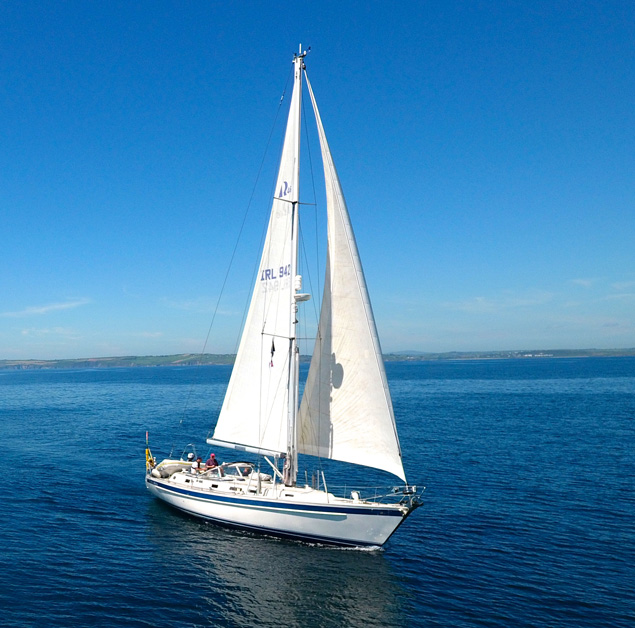 Time out. Jack and Rosemary Roy’s Hallberg Rassy 46 Tangaroa catches a few days of last month’s week of good weather with a short cruise off West Cork
Time out. Jack and Rosemary Roy’s Hallberg Rassy 46 Tangaroa catches a few days of last month’s week of good weather with a short cruise off West Cork
So although as the season eventually draws to a close in three months time we’ll hope to hear the views of the President on items which some people see as controversial, such as the clashing of major fixture dates and the development of Dun Laoghaire harbour’s sailing structure, for now we take inspiration from his joy in boats and sailing, and his seemingly infinite enthusiasm for putting so much back into a sport which continues to give him so much pleasure.
And though like many sailing folk he’d been vaguely hoping that this weekend might provide a bit of chillout time, we know that on this Saturday morning he’ll arrive aboard Tangaroa in Kinsale to give her a good clean-up to be ready for duties next week in Glandore, where he is in attendance at the Glandore Classic Regatta as President of Irish Sailing. That’s the way life is with Jack Roy.
































































